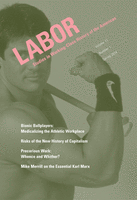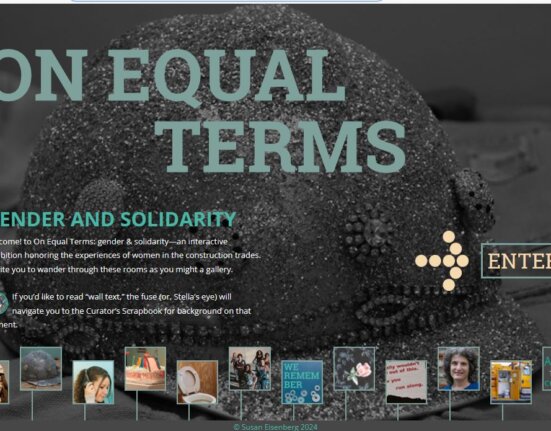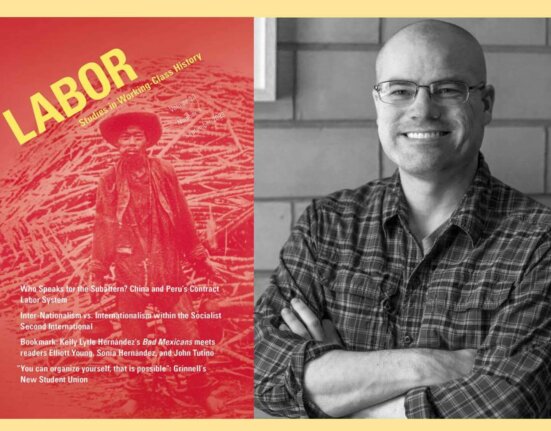In This Issue
The Common Verse
- Carl Wade Thompson, “Off Shore“
LAWCHA Watch
- Nancy MacLean, “Connecting Members and Communities“
Contemporary Affairs
- Marcel van der Linden, “San Precario: A New Inspiration for Labor Historians”
Precariat refers to groups of people who previously had been known as the casual poor, that is, workers who have no control over their destiny and depend on the goodwill of others. Precarious employment relations are temporary, involving jobs that last a day, a week, or a few months at most. In this short essay Marcel van der Linden discusses the definition of precarious labor, its long history, its decline and rise in the advanced capitalist countries after World II, its growth in the global South, and its problematic relationship with organized labor.
Articles
- Jeffrey Sklansky, “Labor, Money, and the Financial Turn in the History of Capitalism”
Recent years have seen a revival of innovative historical studies of American capitalism. They differ in key respects from the social history of the 1960s, 1970s, and 1980s, which likewise took capitalism as a central concern. The older social history focused on the organization of labor, in the double sense of how work was organized in the process of production and how workers organized themselves in trade unions, political parties, and social movements. Much of the new history of capitalism focuses instead on the organization of capital, particularly finance, pushing earlier concerns about labor and class to the margins. In this essay, Jeffrey Sklansky relates the gap between the history of finance and the history of labor to a long-standing tendency to conceive of capitalist relations in terms of an essential dichotomy of labor and money. He argues that the labor-versus-money divide has not only thrown into stark relief the profound tension between the imperatives of productivity and profit but has also tended to distort or disguise the basis of capitalist development in class struggle. To do so, he examines the assumptions underlying the older and newer approaches and critiques a handful of leading new works on the history of early American finance. Finally, some suggestions are offered for bringing the new focus on finance to bear on the still-pressing questions at the heart of the older history of labor, through the study of class struggles over the means of payment as well as the means of production.
- Sarah F. Rose and Joshua A. T. Salzmann, “Bionic Ballplayers: Risk, Profit, and the Body as Commodity, 1964 – 2007”
In this article the authors explore the dramatic shifts in the business of baseball that drove the medicalization of the game and players’ bodies. Before the advent of salary arbitration (1974) and free agency (1976), ballplayers were disposable parts in a high-risk work environment. Buoyed by exploding television revenues, the free agent market drove players’ salaries into the millions, transforming the economics of bodily management. Enticed by the prospect of riches, players and teams harnessed fitness training, reconstructive surgery, biomechanical analysis, and performance-enhancing drugs to reduce wear and tear on players’ bodies and, ultimately, radically alter them for profit. This interplay between economic incentives and medicine created what the authors call “bionic ballplayers”: bigger, stronger, and at times more fragile than their predecessors. By attacking individual ballplayers’ morality, commentators have obscured the more salient issue: baseball is representative of the fact that Americans increasingly live in an age of biotechnology in which bodily modification for profit has become the norm and often an unstated job requirement. In this postindustrial age, the body remains a crucial means of production. Thus, the authors suggest that the question raised by steroids is not only individual morality but also the morality produced by a political economy of labor that calls for both services and body parts rendered.
- Matthew M. Mettler, “AFL Community Unionism: The Des Moines Department Store Strike of 1939”
Matthew M. Mettler examines a 1939 strike of building service workers against Des Moines’s largest and most popular department store, Younkers, and its allies in the city’s nascent retailers’ association that lasted for five weeks. Although the strike failed to achieve the workers’ principal demand for a closed union shop, it marked the first time that the city’s labor movement and civil rights movement began to reinforce one another. The Building Service Employees International Union local at the center of the strike was affiliated with the American Federation of Labor (AFL) and consisted of thirty-six janitors, porters, and workmen — twenty of whom were African American. This strike was the first majority African American picket line in the city’s history, and the black community watched to see if the white labor movement would move beyond its history of racial exclusion. Leading the charge to break away from this history was the city’s insurgent and militant Teamsters union, Local 90. The Des Moines Teamsters quickly transformed a dying local into the city’s largest and most influential union in the city. Local 90 took over the city’s venerated AFL Trades and Labor Assembly from craft unionists and first used it to revitalize Des Moines’s working-class community and then extended it to include the city’s African American workers. The Younkers strike illustrates an overlooked dynamism at the heart of AFL labor organization in the 1930s and shows how community-based unionism could provide the foundation for progress in race relations.
Collective Wisdom
- Michael Merrill, “On Our Marx: Exploitation, Crisis, and Capitalism in the Twenty-First Century”
In an extended review essay, labor studies scholar Michael Merrill evaluates three recent major works on Marx and Marxism. While crediting all three authors — Eric Hobsbawm, Michael Heinrich, and Fredric Jameson — with significant insights, he takes the latter two to task for uncritically accepting Marx’s argument about the inevitability of labor’s exploitation in market societies and, drawing upon a wide-ranging literature, offers an alternative perspective.







